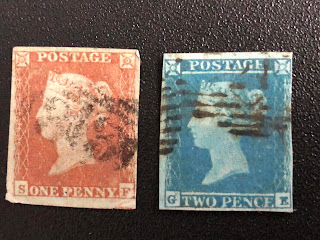 |
| The Penny Black, 1840 |
This is a story about image. First, the Penny Black, the first prepaid postage stamp in the world. The stamp was issued in 1840 and used only for a year when the Royal Mail people realized that the black color made it difficult to see the black cancellation. For awhile they switched to red cancellations. Then they switched to printing the stamp in red.
As the world's first prepaid adhesive postage stamp the Penny Black was a welcome innovation. Prior to that time the recipient of a letter had to pay for the postage which was calculated on the number of miles from its origin and the number of sheets of paper. With the introduction of postage stamps the volume of mail went up significantly. The Penny Black is still widely available to collectors. It's expensive as a single postage stamp but relatively affordable. Sometimes you can get lucky. I recently bought this copy in an eBay auction for the price of a nice lunch for two.
 |
| The Penny Red and Penny Blue stamps, 1841 |
The Penny Red along with the Penny Blue (actually a 2 pence stamp) was originally imperforate, meaning it did not have perforations between each stamp so that an individual stamp could easily be torn from a sheet. Each stamp had to be cut from the sheet with scissors.
In 1854 the Penny Red was issued with perforations so each stamp could be torn off the sheet. The problem with imperforate stamps was that if a person cut too hastily they might actually cut into the stamp next to it. You can actually find specimens with part of another stamp to one edge or another.
 |
| The 1854 Penny Red |
The next change was in the upper right and left corners. Stamp designers were always trying to stay one step ahead of counterfeiters and those who attempted to re-use stamps. One trick that enterprising people tried was to take two stamps, one with the cancellation on the top and one with the cancellation on the bottom. They would cut each stamp in half and put them together to make a composite stamp. This would only work as long as the stamp had Maltese crosses in the upper corners.
The letters in the bottom corners indicated the stamp's position on the printing plate. The 1854 stamp to the left was in rank O and column L, for instance.
In 1861 the upper and left corners were changed to have the same letters as in the bottom corners, except they were reversed. This made it virtually impossible for someone to clip two stamps and make a composite one.
The green stamp below is one of the two last stamps issued during Victoria’s reign in 1899. She was born in 1819 and reigned from 1837-1901. 63 years. In that time the same portrait was used on British stamps. No wonder the British thought she would live forever. She didn’t age a day if you took these images literally.
The purple stamp below is from Canada about 1899 or so. This one has an honest portrait of her in old age. Interestingly, British coinage issued later in her reign showed her as older. Colonial stamps also depict her with a lot more variety than the stamps in Britain. Coinage from Victoria's reign also shows a progression in her age, I've never seen any rationale given for the perpetuation of the youthful portrait. It wasn't used consistently in all contexts in which an image of the queen would be used. Perhaps the expense of engraving a new portrait was too much? I would expect that the engraving of a new design wouldn't be any more expensive than the production of a new coin.
Royalty, no matter when, have always relied on image. Queen Elizabeth I (r. 1558-1603) was famously obsessed with her public image to the extent that she had any depiction of her banned that did not show her as a young, vibrant woman. Later portraits of her depict her as younger, but they are stiff and do not look like portraits taken from life (which is something you could probably say about many English portraits from that time). There are a few remarkable survivors, though, showing Elizabeth as a tired, elderly woman. Victoria also changed with age, as we all do, becoming increasingly stout, something not difficult to do if you're only five feet tall.
I doubt that anyone in Britain was fooled by the eternally youthful picture of Queen Victoria on their stamps. Perhaps they saw this depiction of her as being of her spirit, which never aged. After Albert's death she appeared in public infrequently, although she remained actively engaged in the affairs of government.
In the end, of course, the perpetually youthful Victoria of the postage stamp died as we all do. So goes the world.



No comments:
Post a Comment